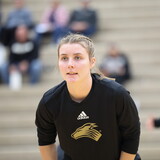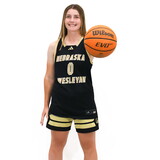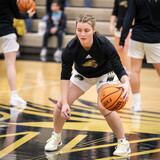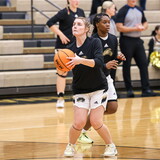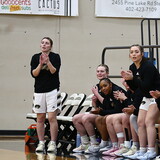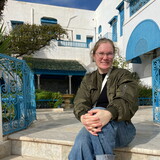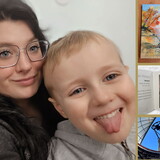First-year student Leah Loostrom grew up on a farm near Gothenburg where she has fond childhood memories of playing with sticks.
The Nebraska Wesleyan University art major, who hopes to one day become an architect, spent the first days of her summer break playing with sticks again.
“This is a nice change of pace from the classroom,” Loostrom said.
Loostrom joined 10 other Nebraska Wesleyan University art students who spent nearly two weeks manipulating and weaving seven tons of sapling trees and branches into a large-scale installation at a private sculpture garden in Lincoln.
For 15 years, Robert and Karen Duncan have dreamed of adding an infamous stick sculpture to their estate. The stick art first grabbed their attention while visiting Lamar Sculpture Park in St. Louis.
“Once you see his work, you never forget him,” Karen Duncan said of internationally-acclaimed artist Patrick Dougherty. “We had to get in line. His work is popular all across the world.”
Born in Oklahoma and raised in North Carolina where he earned a bachelor’s degree in English, Patrick Dougherty led a successful career in hospital and health administration. But a love for nature and carpentry continued to tug at his heartstrings and he returned to college to study art history and sculpture.
That’s when Dougherty first began experimenting with tree saplings as construction material. His work soon evolved from single pieces on conventional pedestals to monumental scale environmental works, which required saplings by the truckload. Over the last 30 years, Dougherty has built over 230 “stickwork” exhibits across the world.
He spends approximately three weeks per project, which begins by collecting saplings from the local area. The branches are cleaned and cut then weaved into an artistic masterpiece.
Due to each project’s size and scale, Dougherty does not work alone. Years ago he sought out volunteers. Now when word gets out that he is working in the area, volunteers are calling him.
“All I ask is that they try,” Dougherty said of his volunteers. “The responsibility ultimately falls on me.”
Last fall Lisa Lockman, Nebraska Wesleyan University professor of art, was visiting with Ann Pagel, curator for the Duncan’s art collection.
“When I heard Patrick Dougherty was building an exhibit in Lincoln, I immediately told her that our students would help,” said Lockman.
Lockman said the experience would provide a wonderful opportunity to work outside of the classroom alongside an internationally-acclaimed artist.
Students worked in two four-hour shifts each day rain or shine, hot or cold. Dougherty taught them to use the sticks as their canvas: bending, breaking, cutting, manipulating and erasing any weaknesses in the structure. Dougherty also used the long hours together to discuss life as a working artist.
“I think it’s hard for them to envision,” he said. “This project makes it real for them. It’s problem-solving — what works, what doesn’t — and having them see the value in what they do.”
“It’s like putting together a puzzle, said junior art major Gwendolyn Lopez. “You learn to know the sticks — what will hold in place and what will hold other sticks in place.”
Lopez, who plans to work in an art gallery or museum, didn’t deny the project’s challenges.
“Sticks would break and that would get frustrating,” she said. “Sculpture is new to me so this is a good experience.”
The collaboration resulted in three side-by-side classical huts named “Three Of A Kind”.
“I wanted it to have synergy with the rest of the site, something that was reflective of the Duncan’s house, a gateway to their place,” said Dougherty.
“We love it,” said Robert Duncan. “And knowing students were involved is very gratifying.”
As the artist and art students finished their work, Dougherty reminded them of the project’s most important lesson.
“Hands-on learning communicates more than any words could ever convey,” he said. “They had a real product at the end of it all but hopefully they got so much more out of it.”
For Loostrom the project reinforced her interest in architecture.
“This project confirmed for me that I do want to become an architect and create buildings that people can walk through and enjoy for a lifetime,” she said. “But this wasn’t just about the sticks. I’m leaving with some great advice and life pointers. This project continued to remind me of the importance of striving for your goals.”




